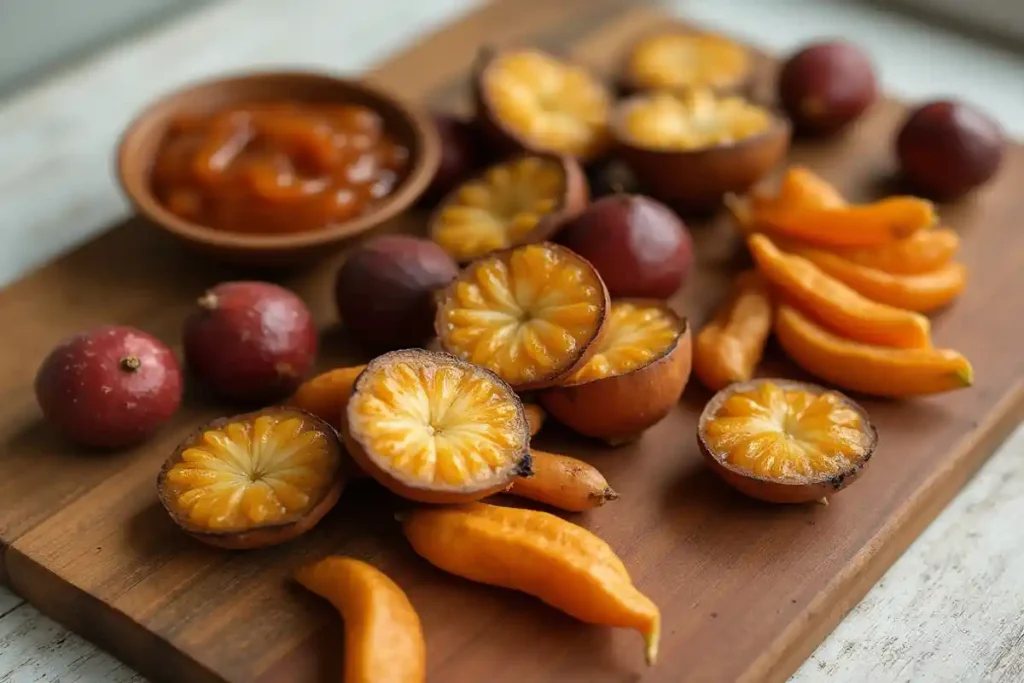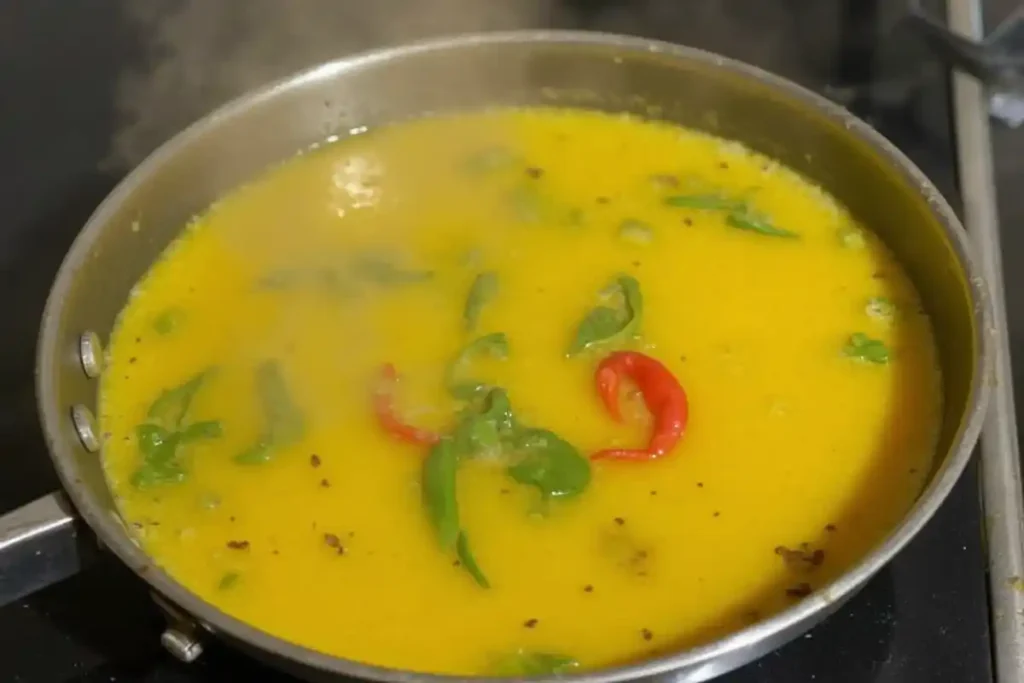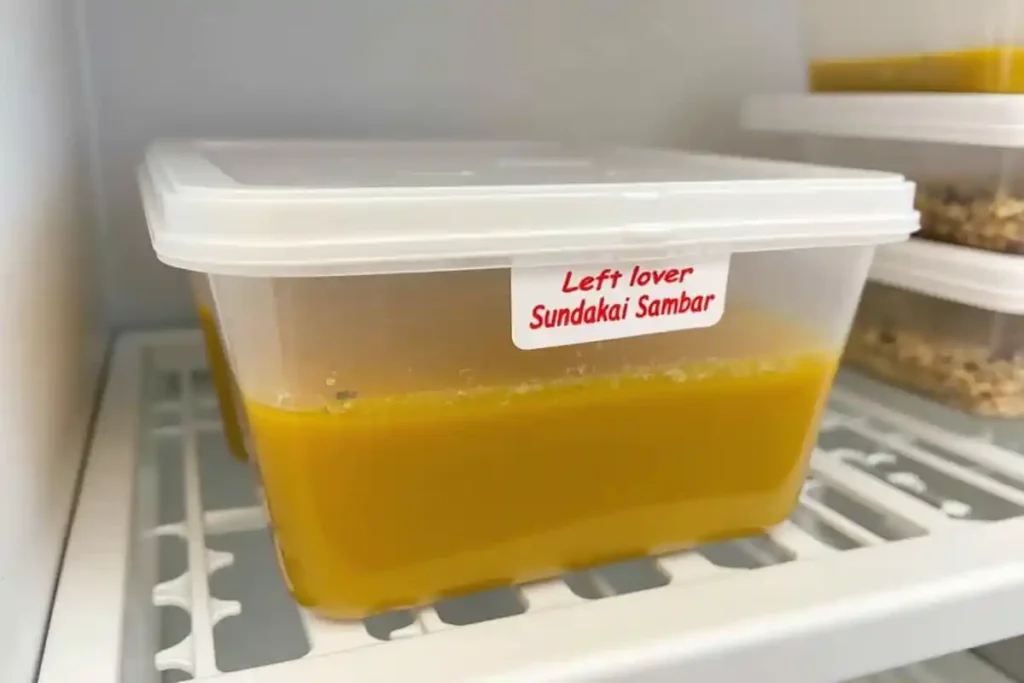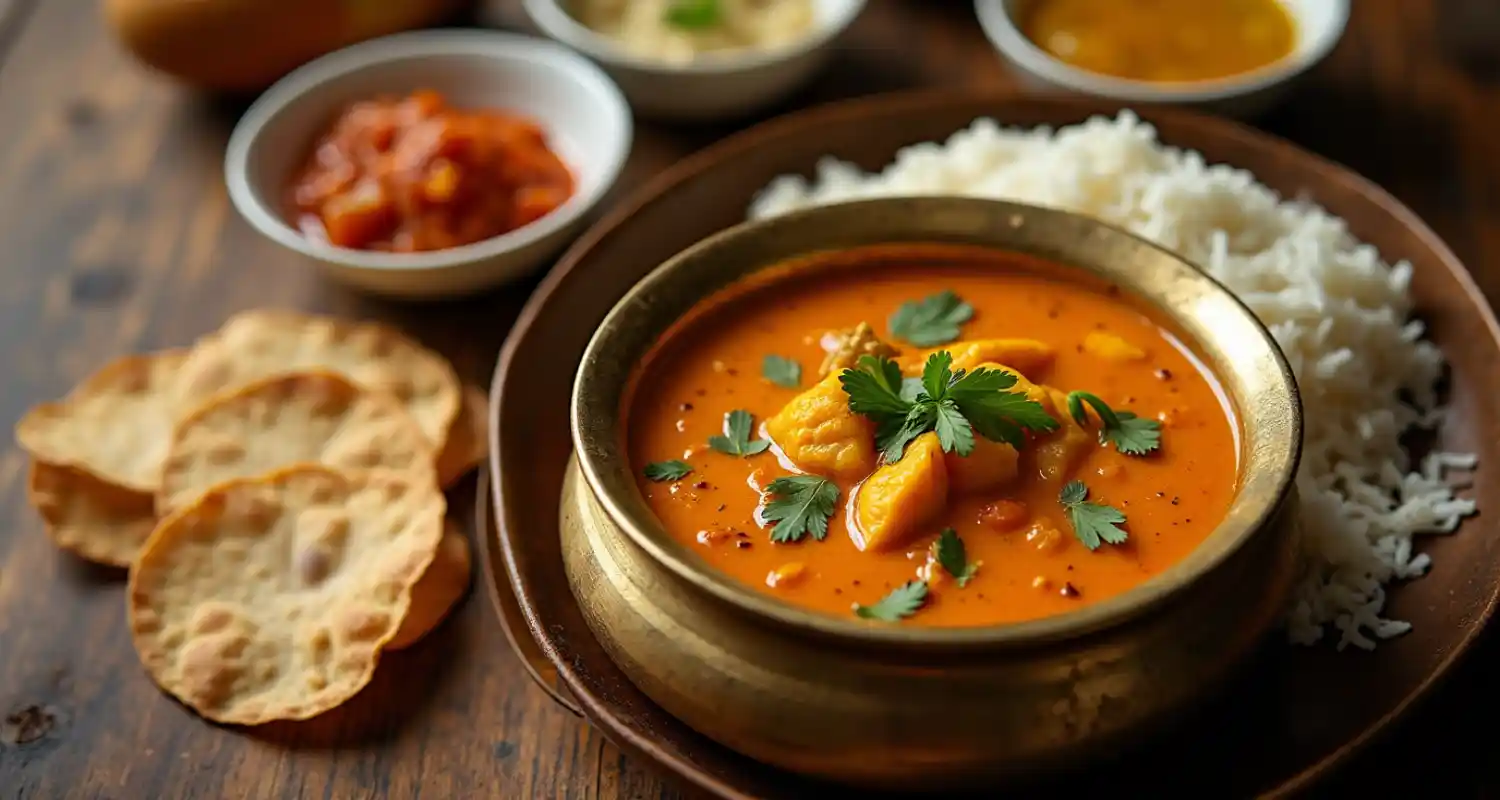A Dish That Connects Generations
There’s something special about the way food can transport us through time. The fresh green Sundakai sambar recipe is more than just a dish—it’s a nostalgic connection to my childhood and my grandmother’s loving care. I can still picture her bustling around the kitchen on Sunday mornings, selecting the freshest Sundakai (Turkey berries) with meticulous precision. She would often say, “These tiny berries hold the secret to strong health!”
Sundakai sambar wasn’t just another meal; it was the ultimate South Indian comfort food, bringing everyone together for family gatherings. Served with a mound of fluffy rice, crispy appalams, and a dollop of ghee, it had the power to bring us all together at the table. Nothing compares to the aroma of the fresh green Sundakai sambar recipe, simmering with tangy tamarind and fragrant spices, evoking memories of home.
If this is your first time preparing Sundakai sambar, I invite you to make it your own and discover the magic it brings—not just to your plate but to your heart.
Table of Contents
History and Cultural Significance of Sundakai Sambar
The fresh green Sundakai sambar recipe is a cherished part of South Indian cuisine, deeply rooted in tradition and wellness. This traditional sambar recipe is a staple of daily meals across Tamil Nadu, Kerala, and Karnataka, and Sundakai adds a unique twist with its slight bitterness and nutritional benefits.
Historically, Sundakai has been celebrated in Ayurveda for its medicinal properties. Ancient texts praise its ability to balance digestion, reduce inflammation, and strengthen immunity. This made it a staple ingredient in households that valued not only taste but also health-conscious cooking.
The dish also plays a significant role in festivals and special occasions. During festivals, this traditional sambar recipe with Sundakai is prepared as a centerpiece, symbolizing nourishment and celebration. The addition of Sundakai elevates the dish, turning it into a blend of flavor and wellness that exemplifies South Indian culinary philosophy.
Over the years, the fresh green Sundakai sambar recipe has transcended its traditional roots, becoming a dish cherished for its flavors and legacy, whether for its robust flavors or its association with home and heritage. Each bowl tells a story of family, culture, and the timeless joy of sharing a meal.
Why This Recipe Will Become Your Go-To Dish
Sundakai sambar is more than just a recipe—it’s a deliciously simple solution to your mealtime dilemmas. Here’s why this fresh green Sundakai sambar recipe should be a regular in your weekly meal plans:
- Quick and Convenient
In just 30 minutes, you can create this easy vegetarian curry that’s bursting with bold South Indian flavors. With easy-to-find ingredients and simple steps, this recipe is perfect for both beginners and experienced cooks.
- Packed with Flavor
With the fresh green Sundakai sambar recipe, you’ll enjoy the perfect balance of tangy tamarind, subtle bitterness, and aromatic spices in every bite. This sambar is the perfect balance of tangy, savory, and spicy.
- Versatile for Any Occasion
Whether for a family lunch, cozy dinner, or weekly meal prep, the fresh green Sundakai sambar recipe fits the bill beautifully. It pairs wonderfully with rice, idli, dosa, or even quinoa, making it adaptable to your preferences.
- Customizable to Your Tastes
Prefer it mild? Use less sambar powder. Love a fiery kick? Add green chilies or black pepper. This dish is as flexible as your imagination.
- A Taste of Tradition
Sundakai sambar brings the authenticity of South Indian flavors to your table, making it a perfect way to experience regional cuisine from the comfort of your home.
Nutritional Benefits of this fresh green Sundakai Sambar recipe
Sundakai sambar isn’t just about bold flavors—it’s a dish that packs a punch of nutrients with every serving. Each ingredient in this healthy Indian vegetarian dish contributes to your well-being, making it a wholesome choice for any meal.
Sundakai (Turkey Berry)
- Iron-rich superfood: Helps combat anemia and boosts energy levels.
- Rich in Antioxidants: The fresh green Sundakai sambar recipe combines antioxidants that fight inflammation and protect against oxidative stress.
- Digestive Support: Traditionally used to prevent stomach infections and improve gut health.
The fresh green Sundakai sambar recipe incorporates Turkey berry as its star ingredient, offering nutritional benefits and a delightful bitterness to elevate the dish.
Toor Dal (Split Pigeon Peas)
- Protein-Packed: Vital for supporting muscle repair and growth.
- Fiber for Gut Health: It Aids digestion and keeps you feeling full longer.
- Heart-Healthy Minerals: Potassium and magnesium help maintain stable blood pressure.
As the creamy base of sambar, toor dal provides the perfect balance of nutrition and texture.
Tamarind: The Tangy Touch
- Rich in Vitamin C: Supports immunity and enhances iron absorption.
- Improves Digestion: Stimulates bile production for better fat metabolism.
- Natural Anti-Inflammatory: Its polyphenols promote overall health.
The tangy tamarind in the fresh green Sundakai sambar recipe beautifully complements its bitterness, creating a harmonious flavor profile.
With these ingredients working together, Sundakai sambar becomes a dish that nourishes your body as much as it delights your taste buds.
Fresh Green Sundakai Sambar Recipe
Course: Main DishCuisine: South IndianDifficulty: Easy4
servings10
minutes20
minutes180
kcal30
minutesThis fresh green Sundakai sambar recipe offers a tangy and savory dish that pairs beautifully with rice.
Ingredients
Fresh green Sundakai (Turkey berry): ½ cup
Toor dal (split pigeon peas): ½ cup
Tamarind: Lemon-sized ball
Sambar powder: 1 tbsp
Turmeric powder: ¼ tsp
Mustard seeds: ½ tsp
Curry leaves: 1 sprig
Dried red chilies: 2
Hing (asafoetida): A pinch
Salt: To taste
Oil: 2 tsp
Fresh coriander: For garnish
Directions
- Prep the Ingredients: Rinse and soak the toor dal. Clean and lightly crush the Sundakai to remove seeds. Soften tamarind in warm water and extract its tangy juice.

- Cook the Dal: Pressure cook the dal with water and turmeric until soft. Mash and set aside.

- Sauté the Base: Heat oil in a pan. Toss in mustard seeds, curry leaves, dried chilies, and a pinch of hing. Toss in the Sundakai and sauté for a few minutes.

- Build the Sambar: Pour in the tamarind juice and add sambar powder. Simmer until Sundakai softens.

- Combine: Add mashed dal to the pan and mix well. Add water to achieve the desired consistency, then season with salt. Let it simmer for 5-7 minutes.

- Finish: Garnish with fresh coriander and serve hot with rice.

Notes
- Frying the Sundakai before adding tamarind juice enhances its flavor.
Add a dash of jaggery to balance the bitterness of Sundakai.
Secrets to the Ingredients for Perfect Sundakai Sambar
The magic of Sundakai sambar lies in the thoughtful selection and preparation of its ingredients. Understanding these secrets ensures your dish is both flavorful and true to its roots.

Sundakai (Turkey Berry)
- Always choose fresh Sundakai for the best flavor. If unavailable, dried Sundakai (soaked and fried) can be a good substitute.
- Lightly roast Sundakai before simmering to reduce bitterness and bring out its natural sweetness.
Fun Fact: Sundakai translates to “pea eggplant” in Tamil, reflecting its small, round shape and slightly bitter taste.
Tamarind
- Fresh tamarind pulp is ideal for achieving an authentic tangy flavor.
- In a pinch, tamarind paste works, but it’s best to avoid overly processed options.
For creative variations, you can substitute tamarind with amchur (dried mango powder) or kokum, though these alternatives slightly alter the traditional flavor.
Toor Dal
- Always soak the dal before cooking to speed up the process and ensure even cooking.
- For a different texture, you can experiment with moong dal or masoor dal.
Spices and Aromatics
Use freshly ground sambar powder for the best flavor. Store-bought varieties are convenient but may lack the depth of homemade blends.
Tempering with mustard seeds, curry leaves, and dried chilies is essential—it elevates the dish’s aroma and adds an unmistakable South Indian touch.
Easy Steps for a Successful Fresh Green Sundakai Sambar Recipe
Making the fresh green Sundakai sambar recipe may seem complex at first, but it’s surprisingly easy with a step-by-step approach.

Follow these steps to create the perfect fresh green Sundakai sambar recipe every time:
- Prepare the Sundakai:
- Wash the Sundakai thoroughly and lightly crush each one. This helps release its natural juices and removes any seeds, which can be overly bitter.
- Cook the Dal to Perfection:
- Pressure cook the toor dal with turmeric powder until it’s soft and mushy. Mash it well to achieve a creamy consistency. This ensures the sambar has a smooth, velvety base.
- Temper the Spices:
- Heat oil in a pan, then add mustard seeds, curry leaves, and dried red chilies. The moment the mustard seeds crackle, your kitchen will be filled with the irresistible aroma of South Indian spices.
- Add the Sundakai:
- Sauté the crushed Sundakai in the tempered spices for 2–3 minutes. This step is crucial for mellowing its bitterness and infusing it with the rich flavors of the tempering.
- Simmer with Tamarind:
- This tangy tamarind curry comes together as the tamarind juice simmers with the Sundakai, creating a bold and flavorful dish. The tanginess of tamarind beautifully complements the bitterness of Sundakai.
- Combine and Cook:
- Incorporate the mashed dal into the fresh green Sundakai sambar recipe along with the sambar powder for a creamy texture. Adjust the consistency with water, season with salt, and simmer for 5–7 minutes.
Bonus Step: Garnish with fresh coriander and a splash of ghee just before serving for an added layer of flavor.
Expert Tips for Success
- Balance the Flavors:
Sambar is all about harmony. Taste and adjust the levels of tamarind, salt, and spice to ensure no single flavor dominates. - Roast the Sundakai First:
Lightly roasting the Sundakai in oil before adding tamarind juice brings out its natural sweetness and reduces its bitterness. - Consistency is Key:
If you prefer a thicker sambar, use less water. For a lighter, soup-like consistency, add a bit more. - Fresh Ingredients Make a Difference:
Always use fresh tamarind and spices for the best flavor. Pre-ground spices lose their potency over time. - Use a Heavy-Bottomed Pan:
A sturdy pan ensures even cooking and prevents the sambar from sticking or burning.
By following these steps and tips, you’ll create a Sundakai sambar that’s not only delicious but also a reflection of your care and attention in the kitchen.
Common Mistakes and How to Avoid Them
Even with a simple recipe like Sundakai sambar, a few missteps can impact the final dish. Here’s how to avoid common mistakes:
Overcooking Sundakai
Sundakai has a unique texture that can become mushy if overcooked. Sauté the berries lightly before simmering to preserve their shape and subtle crunch.
Overpowering with Tamarind
Tamarind is key to sambar’s tangy flavor, but too much can make the dish overly sour. Start with a small amount and adjust gradually after tasting.
Skipping the Tempering
The tempering step, where mustard seeds, curry leaves, and hing are sautéed in oil, is non-negotiable. It adds depth and aroma, tying the flavors together beautifully.
Ignoring Consistency
Sambar that’s too thick feels heavy, while a watery version lacks body. Add water slowly until you achieve a consistency that coats the back of a spoon.
Avoid these pitfalls, and you’ll master Sundakai sambar every time.
Variations and Regional Customizations
One of the best aspects of Sundakai sambar is its adaptability. Whether you’re looking to tweak the flavors or explore regional styles, there’s a variation for everyone.
General Customizations
Vegan and Gluten-Free Options
- The recipe is naturally vegan, but ensure the Hing (asafoetida) used is gluten-free, as some brands include wheat as a carrier.
Adjusting Spice Levels
- Love it fiery? Add a couple of finely chopped green chilies or black pepper powder while sautéing the Sundakai.
- Prefer a milder dish? Use less sambar powder and reduce the tamarind for a less tangy flavor.
Alternative Vegetables
- If fresh Sundakai isn’t available, adapt the fresh green Sundakai sambar recipe using okra, brinjal, or drumsticks as substitutes. Each vegetable brings its unique flavor to the dish.
Sweet and Tangy Twists
- Adding a teaspoon of jaggery balances the bitterness of Sundakai and enhances the tamarind’s tangy profile.
Regional Variations
Tamil Nadu Style
- Characterized by a stronger tamarind flavor and a splash of gingelly oil (sesame oil) for added depth.
Kerala Style
- Includes freshly grated coconut or coconut paste for a creamier texture. Coconut oil is also used in tempering, giving the dish a unique aroma.
Andhra Style
- Known for its spiciness, Andhra’s version includes green chilies and extra red chili powder for a fiery kick.
Karnataka Style
- A slightly sweeter take with the addition of jaggery. Karnataka’s version also uses a special sambar powder unique to the region.
By experimenting with these customizations and regional styles, you can create your version of Sundakai sambar that aligns perfectly with your taste preferences while staying true to its South Indian roots.
Serving Suggestions and Meal Pairing Ideas
Picture this: a table set with a steaming bowl of Sundakai sambar at the center, its tangy aroma wafting through the air, tantalizing your senses. The magic of this dish truly comes alive when paired with the right accompaniments, creating a symphony of flavors and textures.

For a Traditional South Indian Lunch
The fresh green Sundakai sambar recipe pairs perfectly with hot, fluffy white rice for a satisfying South Indian meal. Add a drizzle of homemade ghee for an extra layer of richness. Complement the meal with:
- Crispy Papadams (Appalams): Their salty crunch beautifully offsets the sambar’s tang.
- Mango Pickle: A tangy, spicy pickle adds a burst of flavor that contrasts with the smoothness of sambar.
- Thoran or Poriyal: Stir-fried vegetables like cabbage or beans add a mild, crunchy side dish.
As a Cozy Dinner
For a lighter meal, enjoy this healthy Indian vegetarian dish with soft, spongy idlis or crispy dosas. The slight bitterness of Sundakai and the tanginess of tamarind perfectly balance the fermented rice-lentil flavors of these staples.
Create a Feast
For festive occasions, expand the spread to include:
- Rasam: A tangy and peppery soup that complements the richness of sambar.
- Curd Rice: A cooling, creamy dish that provides relief after the spiciness of the main course.
- Payasam: End the meal on a sweet note with this traditional dessert made from jaggery, milk, and lentils or vermicelli.
No matter how you serve it, the fresh green Sundakai sambar recipe will always be the star of your South Indian meal, bringing warmth and bold flavors to your table.
Storage and Reheating Instructions

How to Store Leftovers
Sundakai sambar is kept beautifully, making it an excellent meal prep option. To preserve its flavor:
- Refrigeration: Allow the sambar to cool completely before transferring it to an airtight container. Refrigerate in an airtight container for up to two days.
- Freezing: For longer storage, divide the sambar into portion-sized containers and freeze for up to 1 month.
Tips for Reheating
When reheating the fresh green Sundakai sambar recipe, take care to retain its texture and flavor:
- Stovetop Method: Reheat sambar in a saucepan over low heat. Add a splash of water to adjust the consistency, as sambar tends to thicken when stored. Stir frequently to prevent sticking.
- Microwave Method: Transfer a portion to a microwave-safe bowl, cover loosely, and heat in 1-minute intervals, stirring in between. Add water if needed.
By following these tips, your leftover sambar will taste as fresh and flavorful as the day it was made.
Explore More Recipes You’ll Love
Looking for more delicious ideas to expand your meal repertoire? Here are some recipes that pair beautifully with Sundakai sambar or make a standout dish on their own. Each one is a flavorful journey into diverse culinary delights:
- Gluten-Free Lunch Recipes: Discover a collection of hearty, allergen-friendly dishes that are perfect for a mid-day meal. From rice-based recipes to protein-packed salads, these ideas ensure no compromise on taste or nutrition.
- Old-Fashioned Salmon Patties: Golden and crisp on the outside, tender and flaky on the inside, these patties evoke comforting, nostalgic flavors. Made with simple ingredients, they’re easy to whip up and pair wonderfully with rice or vegetables.
- Beef Pepper Steak with Rice: A savory stir-fry featuring tender beef, vibrant bell peppers, and a peppery sauce. This recipe is perfect for those craving a quick, protein-packed meal with bold flavors.
- Charcuterie Box Lunch Recipes: Elevate your lunch game with these curated charcuterie box ideas. Perfect for picnics, work lunches, or a snackable spread at home, they’re customizable to suit any palate.
- Purple Black Bean Soup Recipe: A vibrant and hearty soup made with nutrient-rich black beans. This dish is not only visually striking but also a comforting choice for a chilly day.
These recipes pair wonderfully with the fresh green Sundakai sambar recipe, making them ideal for your next lunch or dinner plan. Which one will you try next? Share your favorites in the comments!
Frequently Asked Questions
What is Sundakai, and where can I find it?
Sundakai, also known as Turkey berry, is a small green fruit often used in South Indian cuisine. You can find it fresh or dried in Indian grocery stores or online specialty retailers.
What are my options if I don’t have a pressure cooker?
No pressure cooker? No problem! Cook the dal in a large pot on the stovetop. Add water and simmer on low heat for 30–40 minutes until the dal is soft and mushy.
Can I make Sundakai sambar without tamarind?
Yes, you can substitute tamarind with lemon juice or tomato puree. While the flavor will differ slightly, it will still be delicious and tangy.
Is Sundakai sambar suitable for dinner?
Absolutely! Its light yet wholesome flavors make it an excellent dinner option, especially when paired with dosa or idli.
Can I freeze Sundakai sambar?
Yes, Sundakai sambar freezes well. Store it in airtight containers for up to a month. When reheating, add a bit of water to bring it back to the desired consistency.
What are some Sundakai sambar alternatives if I can’t find the berries?
Okra, brinjal, drumsticks, or even carrots are great alternatives to Sundakai. These vegetables absorb the sambar’s spices beautifully.
Why does my sambar taste bitter?
Sundakai’s natural bitterness might be too strong if it isn’t cooked properly. Lightly roast the berries in oil before adding them to the sambar to mellow the flavor.
What’s the best way to serve Sundakai sambar?
The most popular way is with rice, but it’s equally delightful with idli or dosa. Add papadams and chutneys for a complete meal.
Your Turn to Experience Sundakai Sambar
The fresh green Sundakai sambar recipe isn’t just a dish—it’s a tradition, a story, and a connection to the rich tapestry of South Indian culture. From its unique blend of tangy tamarind and earthy spices to the subtle bitterness of Sundakai, every bite is a reminder of the balance between flavor and nourishment. Whether it’s for a quick weekday lunch or a special dinner with family, this recipe brings warmth and authenticity to your table.
Now it’s your turn to bring the fresh green Sundakai sambar recipe to life. Experiment with the variations, adapt the spice levels or serve it with your favorite side dishes. Whether you stick to the traditional method or add your twist, Sundakai sambar is sure to become a cherished addition to your kitchen repertoire.
We’d love to hear about your experience! Did you try a regional variation? Add a creative side dish? Share your thoughts, tips, or a picture of your creation in the comments below. Let’s celebrate this timeless recipe together.
Cooking is an act of love—pass it on, one bowl of Sundakai sambar at a time.








